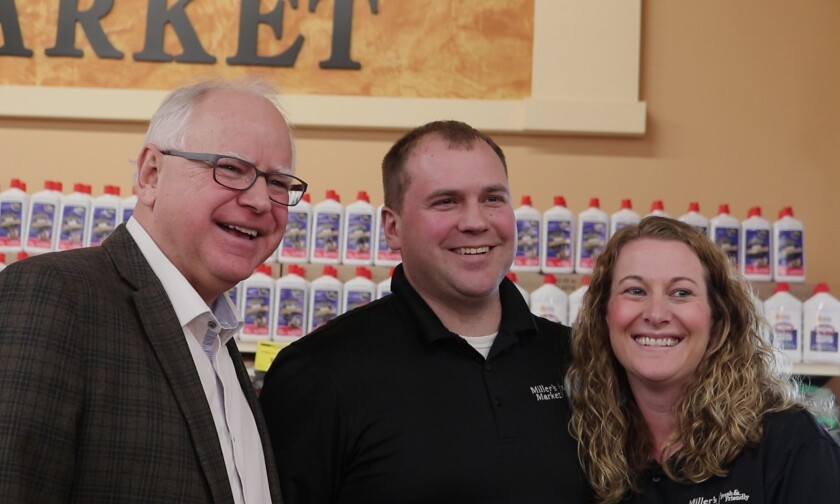ST. CHARLES, Minn. — Minnesota is the No. 1 state in the country when it comes to utilizing Rural Energy for America Program funding.
is a federally funded grant and loan program run by the U.S. Department of Agriculture that helps farmers and rural small business owners access renewable and efficient energy technologies.
ADVERTISEMENT
The program was established through the 2002 Farm Bill, but the made a $2 billion investment in REAP, quadrupling its funding. Before the IRA passed, a farmer or small business owner could receive a grant that covered up to 25% of the cost of solar. Thanks to the IRA, a REAP solar grant now covers as much as 50%.
visited Minnesota on Feb. 1 to highlight USDA's investments in clean energy infrastructure.
Vilsack visited family-owned grocery store Miller’s Market, where he joined Minnesota Gov. Tim Walz to meet with local producers and small business owners that have received funding from REAP.
"As we move towards a cleaner energy future — not getting into the debates around climate change — it makes sense to produce energy as close to home as we possibly can," Walz said. "It makes sense to make sure that people making a profit off that are in the very communities where it's being produced. And it helps lower the bills for the people doing this."
Walz said the detail he was most proud of about the clean energy infrastructure projects was that owners looked to hire in-state contractors to do the work.
"Minnesota is the home to the largest solar manufacturing panel company in North America, because people are embracing it," he said, referring to Heliene’s solar panel factory in northern Minnesota.
Minnesota is the No. 1 state in the country when it comes to utilizing REAP funding, Vilsack told a crowd at Miller's Market in St. Charles.
ADVERTISEMENT
"In the last couple of years, Minnesota has received 495 projects that have been funded through the REAP program," he said. "$53.8 million of USDA resources have been provided to folks like we've heard from here today, in grants to install wind, solar and other renewable projects."
Out of 675 projects nationally the USDA announced for January 2024, Minnesota received 87.
Miller’s Market
Miller’s Market, owned by Jon and Tara Miller in St. Charles, received a $64,000 grant to install a 50-kilowatt solar array that is expected to replace 102,500-kilowatt hours of electricity per year, enough energy to power nine homes and the equivalent of 12.6% of the store’s annual energy consumption.
Across the parking lot is Ace Hardware — also owned by Miller — which was awarded $52,000 to install a 39-kilowatt solar array. That project is expected to replace 78,850 kilowatt hours of electricity per year — 85.5% of their total annual energy usage.

Miller’s family-owned grocery store has been a fixture in St. Charles for 45 years. Miller and his wife took over the operation from his parents in 2019.
"We were just trying to find the right time to get the best return on our investment for that, and it worked out right this past year with the REAP grant," Miller said. "We are a very, very large consumer with all of our refrigeration and stuff here, so it's more just an offset of our monthly costs."
Millers said it's important a community staple like Miller's Market stays around for St. Charles for years to come.
ADVERTISEMENT
"We're the only grocery store in town," he said. "And we try to give back to our local community as much as we can, as one of the larger employers in St. Charles."
Goldberg Farms
Mark and Karen Goldberg of Stewartville received a grant of nearly $78,000 to install a wind turbine on their farm, which will save them $11,520 per year, according to estimates. The construction of the turbine was recently concluded and replaces over 103,000-kilowatt hours of electricity each year.
"We farm about 1,000 acres and are a fourth-generation farm," Karen Goldberg said. "We have a fifth generation on the way, up and coming, so we're trying to preserve everything to be able to pass it on down to our kids."
She said they found out about the REAP funding at a farm show about a year ago, and thought they'd check it out.
"They increased the funding, so it definitely made it a viable option for us to go ahead and look at doing the wind turbines," she said. "The wind turbine will basically produce the energy to pay for the electricity that we use on the farm between both homes, and then we'll be able to sell back on the grid, to help our neighbors with everyone's electricity needs."
Goldberg said she recommends other farms look into REAP funding. Mark Goldberg said the turbine took up very little space on their active farmland.
"We were able to put it right next to just a small waterway, and we didn't use up really any extra farmland," he said. "What we lost of farmland was maybe 5 feet, because a lot of the foundation is underground. It was really something that we thought would be very easy to farm around and not have any impact on our farm."












